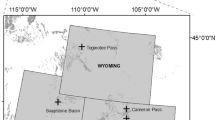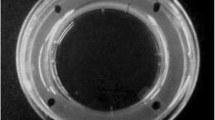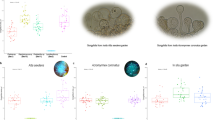Abstract
Multi-trophic interactions between prokaryotes, unicellular eukaryotes, and ecologically intertwined metazoans are presumably common in nature, yet rarely described. The mountain pine beetle, Dendroctonus ponderosae, is associated with two filamentous fungi, Grosmannia clavigera and Ophiostoma montium. Other microbes, including yeasts and bacteria, are also present in the phloem, but it is not known whether they interact with the symbiotic fungi or the host beetle. To test whether such interactions occur, we performed a suite of in vitro assays. Overall, relative yield of O. montium grown with microbes isolated from larval galleries was significantly greater than when the fungus was grown alone. Conversely, the yield of G. clavigera grown with these same microbes was less than or equal to when it was grown alone, suggesting that O. montium, and at least some microbes in larval galleries, have a mutualistic or commensal relationship, while G. clavigera and those same microbes have an antagonistic relationship. A bacterium isolated from phloem not colonized by beetles was found to inhibit growth of both G. clavigera and O. montium and appears to be an antagonist to both fungi. Our results suggest that bacteria and yeasts likely influence the distribution of mycangial fungi in the host tree, which, in turn, may affect the fitness of D. ponderosae.

Similar content being viewed by others
References
Aanen DK, Eggleton P, Rouland-Lefevre C, Guldberg-Froslev T, Rosendahl S, Boomsma JJ (2002) The evolution of fungus-growing termites and their mutualistic fungal symbionts. Proc Nat Acad Sci U S A 99:14887–14892
Adams AS, Six DL (2007) Temporal variation in mycophagy and prevalence of fungi associated with developmental stages of the mountain pine beetle, Dendroctonus ponderosae. Environ Entomol 36:64–72
Araujo WL, Marcon J, Maccheroni Jr W, van Elsas JD, van Vuurde JWL, Azevedo JL (2002) Diversity of endophytic bacterial populations and their interaction with Xylella fastidiosa in citrus plants. Appl Environ Microbiol 68:4906–4914
Arnold AE, Maynard Z, Gilbert GS, Coley PD, Kursar TA (2000) Are tropical fungal endophytes hyperdiverse? Ecol Lett 3:267–274
Bleiker KP, Six DL (2007) Dietary benefits of fungal associates to an eruptive herbivore: potential implications of multiple associates on host population dynamics. Environ Entomol 36:1384–1396
Bottone E, Peluso RW (2003) Production by Bacillus pumilus (MSH) of an antifungal compound that is active against Mucoraceae and Aspergillus species: preliminary report. J Med Microbiol 52:69–74
Breen JP (1994) Acremonium endophyte interactions with enhanced plant resistance to insects. Annu Rev Entomol 39:401–423
Breznak JA (1982) Intestinal microbiota of termites and other xylophagous insects. Annu Rev Microbiol 36:323–343
Bridges JR (1981) Nitrogen-fixing bacteria associated with bark beetles. Microb Ecol 7:131–137
Bridges JR, Marler JE, McSparrin BH (1984) A quantitative study of the yeasts and bacteria associated with laboratory-reared Dendroctonus frontalis Zimm. (Coleopt., Scolytidae). Z Angew Entomol 97:261–267
Callaham RZ, Shifrine M (1960) The yeasts associated with bark beetles. For Sci 6:146–154
Cardoza YJ, Klepzig KD, Raffa KF (2006) Endophytic insect deploys bacteria in oral secretions to defend against gallery-invading fungi. Ecol Entomol 31:636–645
Chacha M, Bojase-Moleta G, Majinda RRT (2005) Antimicrobial and radical scavenging flavonoids from the stem wood of Erythrina latissima. Phytochemistry 66:99–104
Currie CR, Bot ANM, Boomsma JJ (2003) Experimental evidence of a tripartite mutualism: bacteria protect ant fungus gardens from specialized parasites. Oikos 101:91–102
Currie CR, Wong B, Stuart AE, Schultz TR, Rehner SA, Mueller UG, Sung G-H, Spatafora JW, Straus NA (2003) Ancient tripartite coevolution in the attine ant-microbe symbiosis. Science 299:386–388
Garbaye J, Churin JL, Duponnois R (1992) Effects of substrate sterilization, fungicide treatment and mycorrhization helper bacteria on ectomycorrhizal formation of pedunculate oak (Quercus robur) inoculated with Laccaria laccata in two peat bare-root nurseries. Biol Fertil Soils 13:55–57
Grylls BT, Seifert KA (1993) A synoptic key to species of Ophiostoma, Ceratocystis, and Ceratocystiopsis. In: Wingfield MJ, Seifert KA, Webber JF (eds) Ceratocystis and ophiostoma: taxonomy, ecology, and pathogenicity. APS Press, St. Paul, MN, pp 261–268
Holben WE, Williams P, Saarinen M, Särkilahti LK, Apajalahti JHA (2002) Phylogenetic analysis of intestinal microflora indicates a novel mycoplasma phylotype in farmed and wild salmon. Microb Ecol 44:175–185
Hölldobler B, Wilson EO (1990) The ants. Belknap, Cambridge, MA, USA
Klepzig KD (1998) Competition between a biological control fungus, Ophiostoma piliferum, and symbionts of the southern pine beetle. Mycologia 90:69–75
Klepzig KD, Wilkens RT (1997) Competitive interactions among symbiotic fungi of the southern pine beetle. Appl Environ Microbiol 63:621–627
Kumar CG (2002) Purification and characterization of a thermostable alkaline protease from alkalophilic Bacillus pumilus. Lett Appl Micriobiol 34:13–17
Lee S, Kim JJ, Breuil C (2006) Diversity of fungi associated with the mountain pine beetle, Dendroctonus ponderosae and infested lodgepole pines in British Columbia. Fungal Divers 22:91–105
Lim YW, Kim JJ, Lu M, Breuil C (2005) Determining fungal diversity on Dendroctonus ponderosae and Ips pini affecting lodgepole pine using cultural and molecular methods. Fungal Divers 19:79–94
Mocali S, Bertelli E, Di Cello F, Mengoni A, Sfalanga A, Viliani F, Caciotti A, Tegli S, Surico G, Fani R (2003) Fluctuation of bacteria isolated from elm tissues during different seasons and from different plant organs. Res Microbiol 154:105–114
Nielsen P, Sørensen J (1997) Multi-target and medium-independent fungal antagonism by hydrolytic enzymes in Paenibacillus polymyxa and Bacillus pumilus strains from barley rhizosphere. FEMS Microbiol Ecol 22:183–192
Paine TD, Raffa KF, Harrington TC (1997) Interactions among Scolytid bark beetles, their associated fungi, and live host conifers. Annu Rev Entomol 42:179–206
Pirttilä AM, Laukkanen H, Pospiech H, Myllylä R, Hohtola A (2000) Detection of intracellular bacteria in the buds of scotch pine (Pinus sylvestris L.) by in situ hybridization. Appl Environ Microbiol 66:3073–3077
Pleban S, Ingel F, Chet I (1995) Control of Rhizoctonia solani and Sclerotium rolfsii in the greenhouse using endophytic Bacillus spp. Eur J Plant Pathol 101:665–672
Rai R, Dash PK, Prasanna BM, Singh A (2007) Endophytic bacterial flora in the stem tissue of a tropical maize (Zea mays L.) genotype: isolation, identification and enumeration. World J Microb Biotechnol 23:853–858
Robinson RC (1962) Blue stain fungi in lodgepole pine (Pinus contorta Dougl. Var. latifolia Engelm.) infested by the mountain pine beetle (Dendroctonus monticolae Hopk.). Can J Bot 40:609–614
Rumbold CT (1941) A blue stain fungus, Ceratostomella montium N. sp., and some yeasts associated with two species of Dendroctonus. J Agric Res 62:589–601
Saikkonen K, Faeth SH, Helander M, Sullivan TJ (1998) Fungal endophytes: a continuum of interactions with host plants. Annu Rev Ecol System 29:319–343
Schreiber LR, Gregory GF, Krause CR, Ichida JM (1988) Production, partial purification, and antimicrobial activity of a novel antibiotic produced by a Bacillus subtilis isolate from Ulmus americana. Can J Bot 66:2338–2346
Shifrine M, Phaff HJ (1956) The association of yeasts with certain bark beetles. Mycologia 48:41–55
Shishido M, Loeb BM, Chanway CP (1995) External and internal root colonization of lodgepole pine seedlings by two growth-promoting Bacillus strains originated from different root microsites. Can J Microbiol 41:707–713
Six DL (2003) Bark beetle—fungus symbioses. In: Miller TA (ed) Insect symbiosis. CRC, New York, pp 97–113
Six DL (2003) A comparison of mycangial and phoretic fungi of individual mountain pine beetles. Can J For Res 33:1331–1334
Six DL, Bentz BJ (2007) Temperature determines symbiont abundance in a multipartite bark beetle-fungus ectosymbiosis. Microb Ecol 54:112–118
Six DL, Klepzig KD (2004) Dendroctonus bark beetles as model systems for studies on symbiosis. Symbiosis 37:207–232
Six DL, Paine TD (1998) Effects of mycangial fungi and host tree species on progeny survival and emergence of Dendroctonus ponderosae (Coleoptera: Scolytidae). Environ Entomol 27:1393–1401
Solheim HS, Krokene P (1998) Growth and virulence of mountain pine beetle associated blue-stain fungi, Ophiostoma clavigerum and Ophiostoma montium. Can J Bot 76:561–566
Sturz AV, Christie BR, Nowak J (2000) Bacterial endophytes: potential role in developing sustainable systems of crop production. Crit Rev Plant Sci 19:1–30
Upadhyay HP (1981) A Monograph of Ceratocystis and Ceratocystiopsis. University of Georgia Press, Athens, GA, USA
Whitney HS (1971) Association of Dendroctonus ponderosae (Coleoptera: Scolytidae) with blue stain fungi and yeasts during brood development in lodgepole pine. Can Entomol 103:1495–1503
Whitney HS (1982) Relationships between bark beetles and symbiotic organisms. In: Mitton JB, Sturgeon K (eds) Bark beetles in North American conifers. A system for the study of evolutionary biology. University of Texas Press, Austin, TX, pp 183–211
Whitney HS, Farris SH (1970) Maxillary mycangium in the mountain pine beetle. Science 167:54–55
Wilhelm E, Arthofer W, Schafleitner R, Krebs B (1998) Bacillus subtilis an endophyte of chestnut (Castanea sativa) as antagonist against chestnut blight (Cryphonectria parasitica). Plant Cell Tissue Organ Cult 52:105–108
Wu D, Daugherty SC, Van Aken SE, Pai GH, Watkins KL, Khouri H, Tallon LJ, Zaborsky JM, Dunbar HE, Tran PL, Moran NA, Eisen JA (2006) Metabolic complementarity and genomics of the dual bacterial symbiosis of sharpshooters. PLoS Biology 4:e188
Yamamoto I, HoangHoa L, Furuya N, Kurose D, Takeshita M, Takanami Y (2004) Identification of the endophytic bacterial isolates and their in vitro and in vivo antagonism against Ralstonia solanacearum. J Fac Agric, Kyushu Univ 49:233–241
Zipfel RD, De Beer ZW, Jacobs K, Wingfield BD, Wingfield MJ (2006) Multi-gene phylogenies define Ceratocystiopsis and Grosmannia distinct from Ophiostoma. St Mycol 55:75–97
Acknowledgments
We thank Glenn Koepke of USDA Forest Service, Region 1, Lolo National Forest, Superior Ranger District, for his aid in locating field sites, and TK Westlie and LM Schimmelpfennig for their help in the lab. We appreciate comments from three anonymous reviewers. This research was supported by the McIntire-Stennis Cooperative Forestry Program and was conducted as part of Regional Research Project W-187.
Author information
Authors and Affiliations
Corresponding author
Rights and permissions
About this article
Cite this article
Adams, A.S., Six, D.L., Adams, S.M. et al. In Vitro Interactions Between Yeasts and Bacteria and the Fungal Symbionts of the Mountain Pine Beetle (Dendroctonus ponderosae). Microb Ecol 56, 460–466 (2008). https://doi.org/10.1007/s00248-008-9364-0
Received:
Revised:
Accepted:
Published:
Issue Date:
DOI: https://doi.org/10.1007/s00248-008-9364-0




